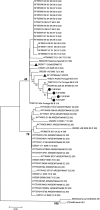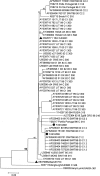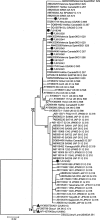Circulation of mumps virus genotypes in Spain from 1996 to 2007
- PMID: 20107099
- PMCID: PMC2849537
- DOI: 10.1128/JCM.02386-09
Circulation of mumps virus genotypes in Spain from 1996 to 2007
Abstract
Although the WHO recommends the use of genotyping as a tool for epidemiological surveillance for mumps, limited data on mumps virus (MV) genotype circulation that may be used to trace the patterns of virus spread are available. We describe the first complete series of data from Spain. The small hydrophobic region was sequenced from 237 MV-positive samples from several regions of Spain collected between 1996 and 2007. Six different genotypes were identified: A, C, D (D1), G (G1, G2), H (H1, H2), and J. Genotype H1 was predominant during the epidemic that occurred from 1999 to 2003 but was replaced by genotype G1 as the dominant genotype in the epidemic that occurred from 2005 to 2007. The same genotype G1 strain caused concomitant outbreaks in different parts of the world (the United States, Canada, and the United Kingdom). The remaining genotypes (genotypes A, C, D, and J) appeared in sporadic cases or small limited outbreaks. This pattern of circulation seems to reflect continuous viral circulation at the national level, despite the high rates of vaccine coverage.
Figures






References
-
- Afzal, M. A., J. Buchanan, J. A. Dias, M. Cordeiro, M. L. Bentley, C. A. Shorrock, and P. D. Minor. 1997. RT-PCR based diagnosis and molecular characterisation of mumps viruses derived from clinical specimens collected during the 1996 mumps outbreak in Portugal. J. Med. Virol. 52:349-353. - PubMed
-
- Atrasheuskaya, A. V., M. V. Kulak, S. Rubin, and G. M. Ignatyev. 2007. Mumps vaccine failure investigation in Novosibirsk, Russia, 2002-2004. Clin. Microbiol. Infect. 13:670-676. - PubMed
-
- Atrasheuskaya, A. V., E. M. Blatun, M. V. Kulak, A. Atrasheuskaya, I. A. Karpov, S. Rubin, and G. M. Ignatyev. 2007. Investigation of mumps vaccine failures in Minsk, Belarus, 2001-2003. Vaccine 25:4651-4658. - PubMed
-
- Boga, J. A., M. de Oña, A. Fernández-Verdugo, D. González, A. Morilla, M. Arias, L. Barreiro, F. Hidalgo, and S. Melón. 2008. Molecular identification of two genotypes of mumps virus causing two regional outbreaks in Asturias, Spain. J. Clin. Virol. 42:425-428. - PubMed
-
- Briss, P. A., L. J. Fehrs, R. A. Parker, P. F. Wright, E. C. Sannella, R. H. Hutcheson, and W. Schaffner. 1994. Sustained transmission of mumps in a highly vaccinated population: assessment of primary vaccine failure and waning vaccine-induced immunity. J. Infect. Dis. 169:77-82. - PubMed
Publication types
MeSH terms
Substances
Associated data
- Actions
- Actions
- Actions
- Actions
- Actions
- Actions
- Actions
- Actions
- Actions
- Actions
- Actions
- Actions
- Actions
- Actions
- Actions
- Actions
- Actions
- Actions
- Actions
- Actions
- Actions
- Actions
- Actions
- Actions
- Actions
- Actions
- Actions
- Actions
- Actions
LinkOut - more resources
Full Text Sources
Medical

